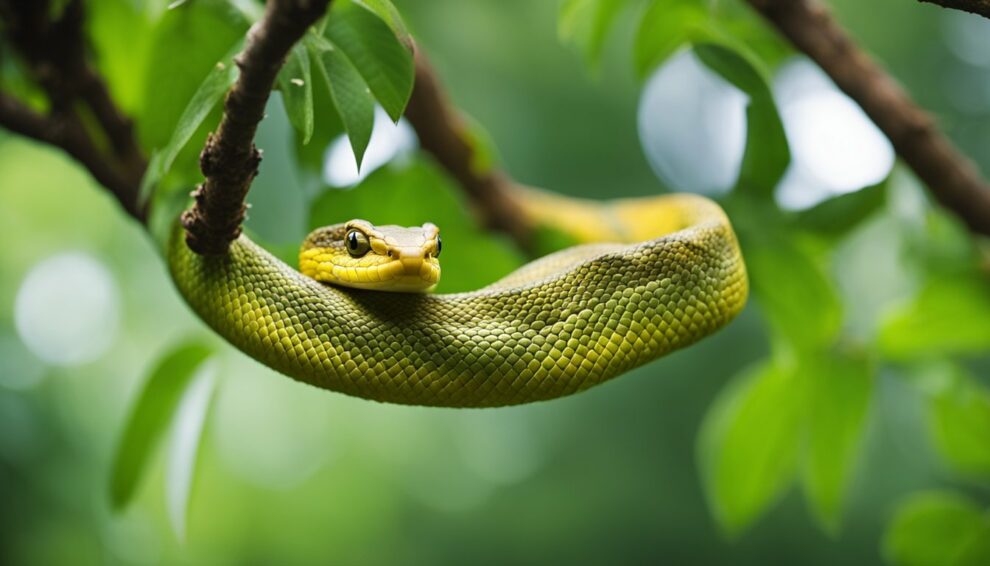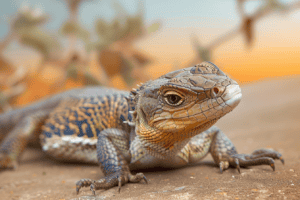Imagine spending your days hanging out in the treetops of a lush, green forest, waiting to ambush your next meal as it scuttles by; this is the life of a bush viper.
These snakes are known for their remarkable tree-hanging hunting techniques, which allow them to blend seamlessly with the surrounding foliage.
The vivid scales of the bush viper provide camouflage that’s as effective as any forest-dweller’s disguise.
From the canopies of Central Africa, they look down upon their territory with a predator’s focus, barely distinguishable from the leaves and branches around them.

The way bush vipers hunt is both smart and sneaky.
They use their prehensile tails to anchor themselves to branches, freeing up their bodies to strike with lightning speed.
When an unsuspecting frog or bird gets too close, the viper makes its move, and within seconds, the prey is captured.
These reptiles don’t waste energy chasing after meals. Instead, they wait patiently, conserving energy until the perfect opportunity presents itself.
Did you know that despite their fierce reputation, bush vipers are actually quite small? Most only grow to about 18 to 24 inches long.
But don’t let their size fool you; what they lack in stature, they make up for with their big impact on the ecosystem.
By controlling the populations of their prey, bush vipers play a critical role in maintaining the delicate balance of their habitats.
As you read on, think about how this stealthy hunter’s technique is not just about survival, but also about the health of the forest they call home.
How do you think you would fare if you were a creature of the treetops?
The Bush Vipers’ Habitat

The bush viper (Atheris squamigera) thrives in the trees of the forest, where its unique physical adaptations allow it to masterfully maneuver and hunt.
Arboreal Adaptations
Bush vipers are designed for life in the trees.
They possess a prehensile tail, which they adeptly use to secure themselves to branches as they move through the canopy.
Their scales are keeled, giving them an almost bristly appearance, which aids in camouflage among the foliage.
The colors of bush vipers vary greatly, ranging from green to orange, allowing them to blend into their leafy surroundings, thus avoiding predators and better surprising their prey.
Climatic Preferences
Preferring the warmth and humidity of the tropics, bush vipers are particularly fond of regions with abundant rainfall.
They inhabit the forests of West and Central Africa where the climate is ideal — warm but not too hot, and with plenty of moisture in the air.
These solitary serpents are most active at night, which is when they seek out their prey.
Do you wonder what it feels like to be out there in the forest at night alongside the bush viper, listening to the sounds of the forest and feeling the humidity in the air?
Hunting Techniques

Bush Vipers use remarkable methods to catch their prey, typically involving stealth and precision.
Let’s explore their tree-hanging tactics and the sensory equipment at their disposal which make them adept hunters.
Tree-Hanging Tactics
These snakes are pros at blending into the dense foliage with their cryptic coloration.
They hang from branches in a J-shape, remaining motionless and incredibly patient. When a naive prey item like a frog or bird happens by, the viper strikes.
This strike is swift and powered by strong muscles along their body.
After a successful strike, their venom, both fast-acting and potent, quickly immobilizes the prey.
Sensory Equipment
Their sensory skills are top-notch for hunting.
They possess heat-sensing pits located between their eyes and nostrils, allowing them to detect even the slightest temperature changes—this clues them in on the presence of warm-blooded prey, even amid the cooler night air.
Furthermore, the textured scales on their body enhance their feel of the environment, providing them with an almost three-dimensional map of their surroundings.
Additionally, their keen vision lets them spot prey amongst the complex patterns of the forest.
Having these adaptations altogether, bush vipers can hunt with remarkable efficiency, using both the vertical stratification of their habitat and their advanced sensory abilities.
These skills combined make them formidable and stealthy predators within their ecosystem.
Diet and Prey

Bush vipers, decked out in their scaly suits of armor, are the masters of ambush in the leafy realms they call home.
Picture this: a vibrant, prickly creature with scales like little daggers, silently lurking among the treetops. They’re on the lookout, but for what?
Ah yes, dinner! They aren’t picky eaters and have quite the varied menu.
These serpentine acrobats primarily snatch up frogs, lizards, birds, rodents, and even some insects that happen to traipse through their treetop domain.
Ever thought about how they manage this without a sound? Their secret lies in their incredible patience and the element of surprise.
With a sudden strike, faster than a blink, the bush viper delivers a swift bite to an unsuspecting passerby.
The venom is the kicker here. It’s not just for show, it immobilizes their prey on the spot.
Think of it as their special move in the predator playbook, making their mealtimes a little less challenging and a lot more successful.
But it’s not all about brute force; precision plays a role too!
They carefully adjust their venom dosage depending on the size of their dinner, showing they’re not just fierce but also clever hunters.
Ever seen a snake eat? It’s quite the sight! No chewing for these reptiles — they swallow their food whole with a jaw that can stretch impressively wide.
It makes one wonder, how comfortable can that be? Yet, the bush viper takes it all in stride.
So next time you see a tree rustling, pause and ponder — might there be a bush viper patiently waiting for its next meal to wander by?
Just imagine being able to witness such a crafty creature in action!
Interaction with the Ecosystem
Bush vipers spend much of their lives lurking among the leaves of trees in the dense rainforests of Africa.
Their vibrant and patterned scales allow them to blend seamlessly into the foliage.
This camouflage is not just for defense—it’s a crucial part of their hunting strategy.
Like little arboreal guardians, they wait patiently for unsuspecting prey such as small mammals, birds, and lizards.
Predation and Control: These serpents play an important role in controlling the populations of their prey, thus maintaining a balanced ecosystem.
They are meticulous in their hunting ways, striking with precision and ensuring that they do not overhunt, which keeps their food sources sustainable.
Have you ever wondered how bush vipers can stay so still and unnoticed for so long?
Their ‘sit-and-wait’ approach to hunting is energy-efficient, requiring less movement and therefore, less food.
These crafty vipers are the ultimate example of patience paying off!
Pollination Helpers: What’s interesting is that they may inadvertently assist in pollination. How, you might ask?
Well, when birds visit flowers for nectar and subsequently become a meal for a bush viper, they may drop pollen they’re carrying.
It’s a small interaction with a potentially big impact!
Ecosystem Indicators: Did you know these snakes could also be indicators of environmental health?
Their presence suggests a thriving, unspoiled ecosystem, while a decline might signal ecological issues.
To sum up, through their unique tree-hanging hunting style, bush vipers serve more functions than just predators; they’re unseen yet vital parts of their habitat.
It’s important for scientists and nature enthusiasts to understand and protect these creatures for the health of our natural world!
Exciting, isn’t it, how much can be learned from observing the life of one small snake in the vast green tapestry of the forest?
Frequently Asked Questions

The frequently asked questions section reveals intriguing details about how bush vipers hunt while effortlessly occupying their treetop havens.
It highlights the unique physical traits that assist in their arboreal lifestyle, the surprising ways they blend into foliage, their dietary preferences, the learning curve for young vipers, and their overall role in their natural habitat.
How do bush vipers catch their prey while hanging from trees?
Bush vipers use a remarkable ambush strategy. They hang from branches, remaining extremely still, and then strike at passing prey with striking speed.
This method relies on patience and the element of surprise.
What adaptations help bush vipers to hunt in the treetops?
These snakes are equipped with a prehensile tail that anchors them to branches, providing stability.
Their long, hinged fangs can inject venom deep into the prey, and their slender, muscular bodies facilitate quick, agile movements amidst the foliage.
In what ways do bush vipers blend into their arboreal environment?
Bush vipers possess scale patterns and colors that mimic the texture and hues of leaves and branches.
This camouflage is vital for both protection and the concealment necessary to ambush prey.
What types of animals are in a bush viper’s diet?
Their diet typically consists of small mammals, birds, lizards, and frogs.
The size and availability of prey influence the variety in their diet, reflecting the rich biodiversity of their ecosystem.
How do young bush vipers learn to hunt in the trees?
Young bush vipers are born with instinctive hunting skills, which they refine over time through practice and observation.
Their early success is critical for survival and further honing of their abilities.
What is the impact of bush viper hunting habits on their ecosystem?
By controlling the populations of their prey, bush vipers play a significant role in maintaining the ecological balance.
Their presence in the treetops highlights the importance of predator-prey dynamics within their environment.









